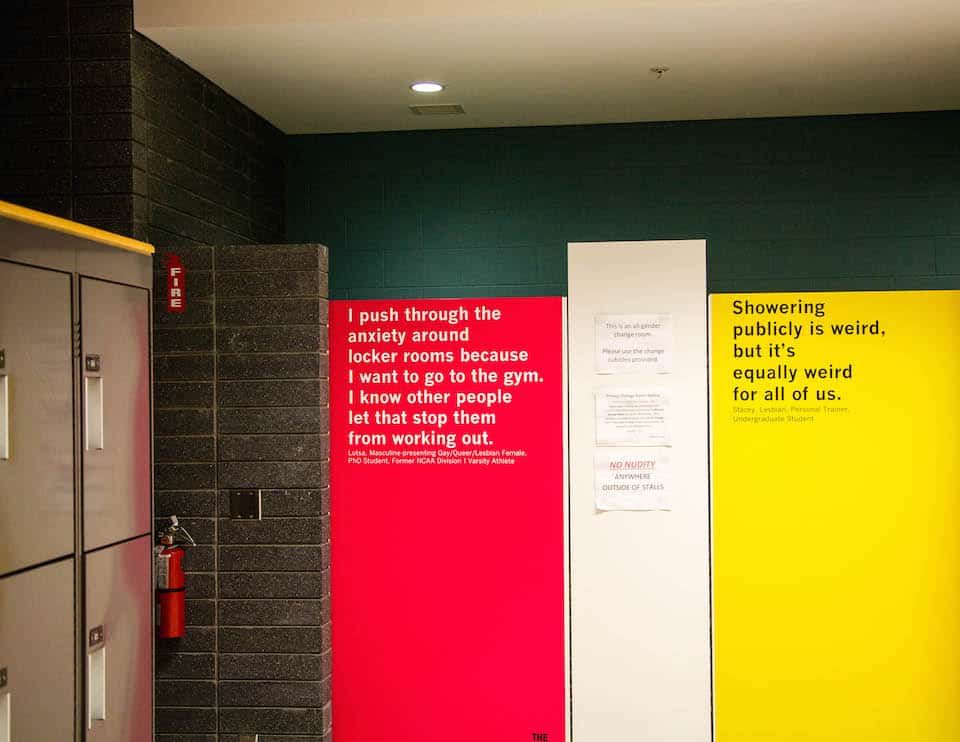In light of the Pan Am Games, the University of Toronto has launched a new initiative called the “Change Room Project.” Initiated by Bruce Kidd, former warden of Hart House and a former Olympian, this research project endeavors to provide a platform for students, especially those who identify as LGBTQ+, to discuss the barriers they face when it comes to participating in physical fitness and recreational activities.
Professor Caroline Fusco, from the Faculty of Kinesiology and Physical Education, worked with Day Milman, program coordinator at Hart House, to create various exhibitions on the locker room walls and facilities across all three U of T campuses. These displays exhibit textual excerpts from interviews with various LGBTQ+ students about their experiences with the social spaces offered by locker rooms and other similar facilities.
“It first started when I got students in my own course to interview each other about Pan Am locker rooms. They then signed consent forms allowing me to use excerpts from their conversations for this project,” said Fusco. Fusco and Milman then put out a call through various LGBTQ+-friendly club mailing lists, to which 12 students responded. Overall, more than 50 students contributed quotations to the project, detailing their own experiences and views on locker rooms.
Fusco and Milman found that anxiety regarding appearances was a recurring theme in the interviews. “One student mentioned that they don’t go to the gym unless it’s with a specific friend as they needed that friend to help them feel safe,” said Milman. They both agreed that the fear of being watched, judged, and commented on were among the most common issues mentioned, and that they disproportionately affected LGBTQ+ students.
Remi Long, member of the Varsity rugby team, said that locker rooms also function as social spaces. “Apart from simply being a place to change, it’s also a place we connect to each other outside of the specific activities of our sport and can talk not only as teammates, but as friends and peers. It’s a place where we get to talk about things other than our sport, and is thereby a space where we do form connections to each other,” she commented.
Stefan Gyocsi, captain of an intramural volleyball team and a regular user of U of T’s athletic facilities, believes that the university offers an inclusive and positive space for all students and supports the Change Room Project in its efforts to lend a voice to LGBTQ+ students. “Since U of T is such diverse hub of people, namely with ethnic background, sexual orientation, body types and lifestyles, each individual here needs to feel included and accepted by the community. The type of effect that this project could have is that it could show the university that its facilities, as inclusive as they are, can always be improved,” he said.
The response, so far, has been a mix of positive and negative; Milman mentioned that some of the negative reception was due to the fact that, for some people, locker rooms are a space where they can de-stress and in which they do not want to come into contact with triggering material; according to Milman, the textual excerpts written on the walls of their locker spaces made the project feel invasive to them.
Both Fusco and Milman hope that the project will shed some light on how people from all walks of life view various societal spaces, and further the university’s ability to act as a supportive, inclusive, and positive space for all students and community members. “We are hoping to turn this project into an academic publication that goes more in depth with the themes brought out through these exhibitions,” said Fusco.


